Abstract
Licochalcone A, isolated from Chinese licorice roots, inhibited the in vitro growth of both chloroquine-susceptible (3D7) and chloroquine-resistant (Dd2) Plasmodium falciparum strains in a [3H]hypoxanthine uptake assay. The growth inhibition of the chloroquine-resistant strain by licochalcone A was similar to that of the chloroquine-susceptible strain. To examine the activity of licochalcone A on the different asexual blood stages of the parasite, licochalcone A was added to highly synchronized cultures containing rings, trophozoites, and schizonts. The growth of the parasites at all stages was inhibited by licochalcone A. The in vivo activity of licochalcone A was tested in a mouse model of infection with P. yoelii. Licochalcone A administered either intraperitoneally or orally for 3 to 6 days protected the mice from the otherwise lethal P. yoelii infection. These results demonstrate that licochalcone A exhibits potent antimalarial activity and might be developed into a new antimalarial drug.
Full text
PDF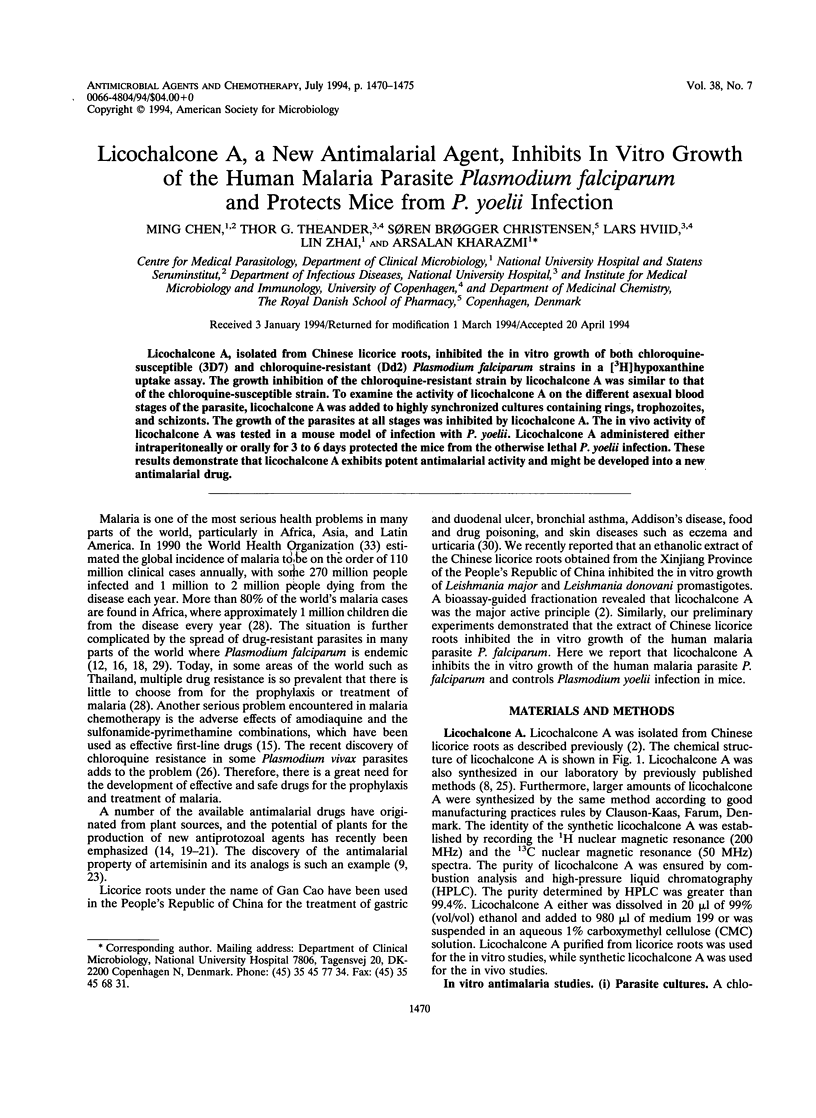
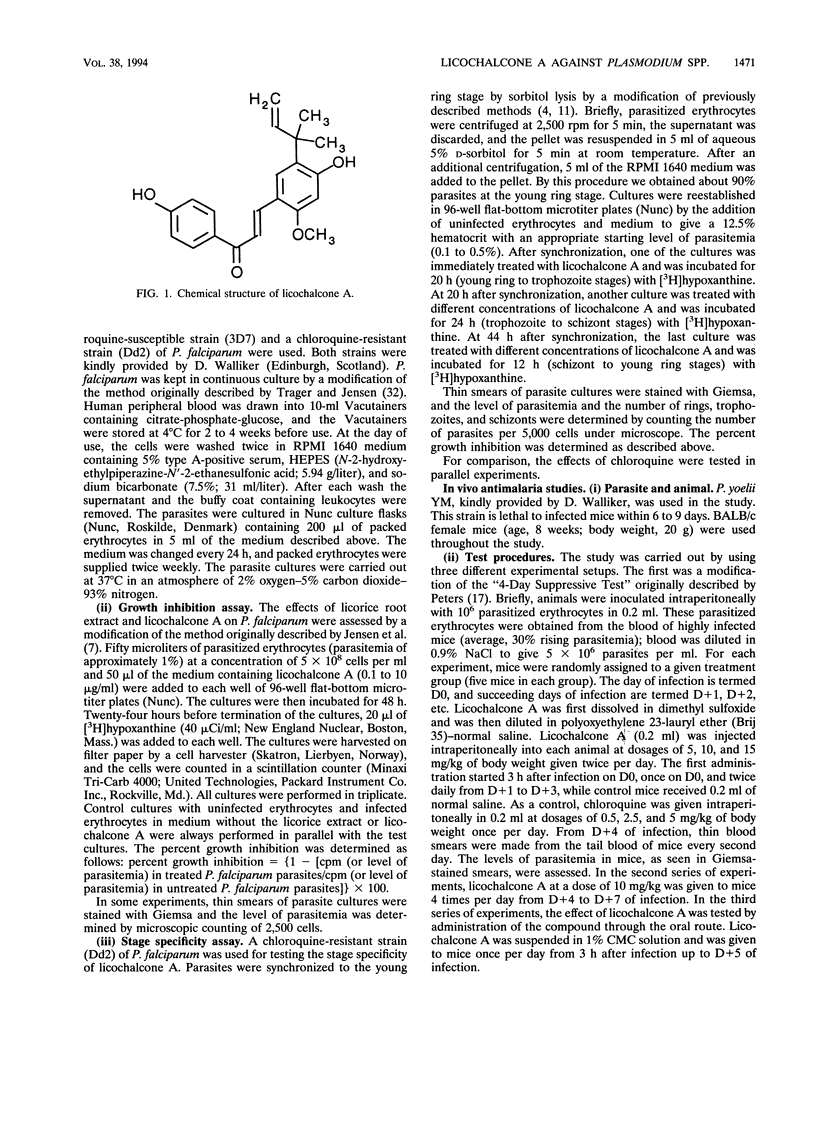
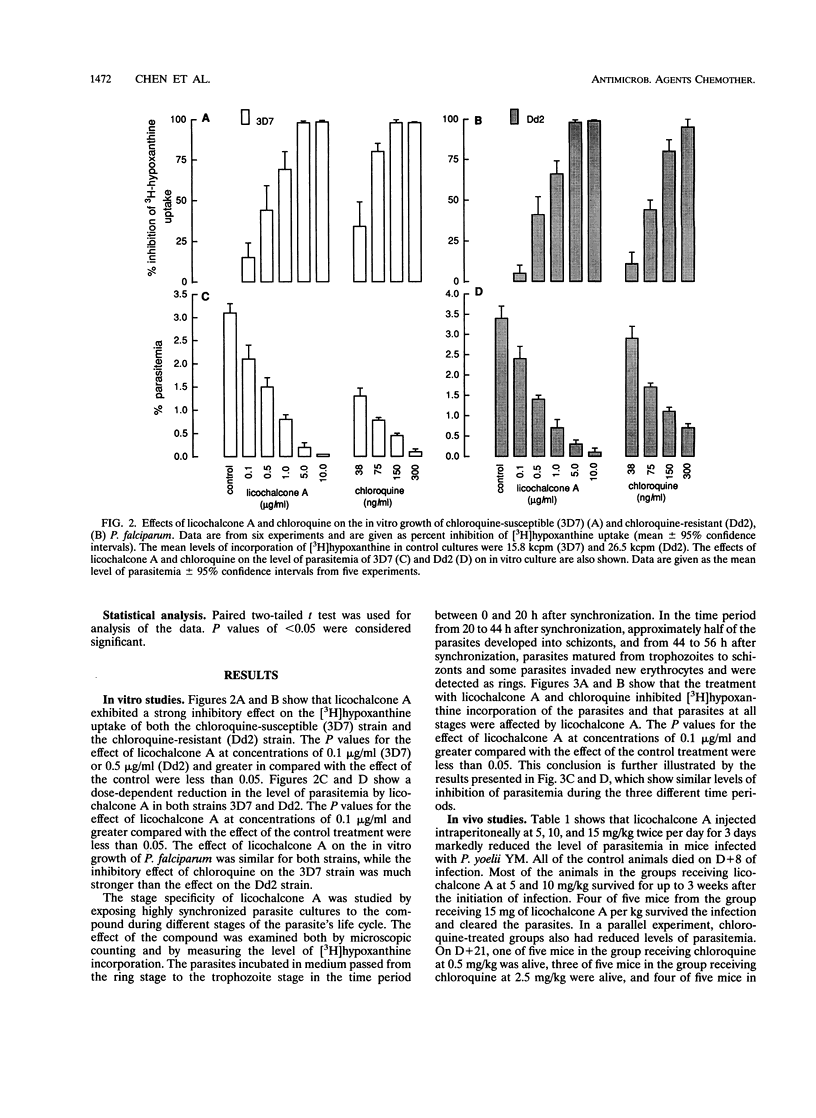
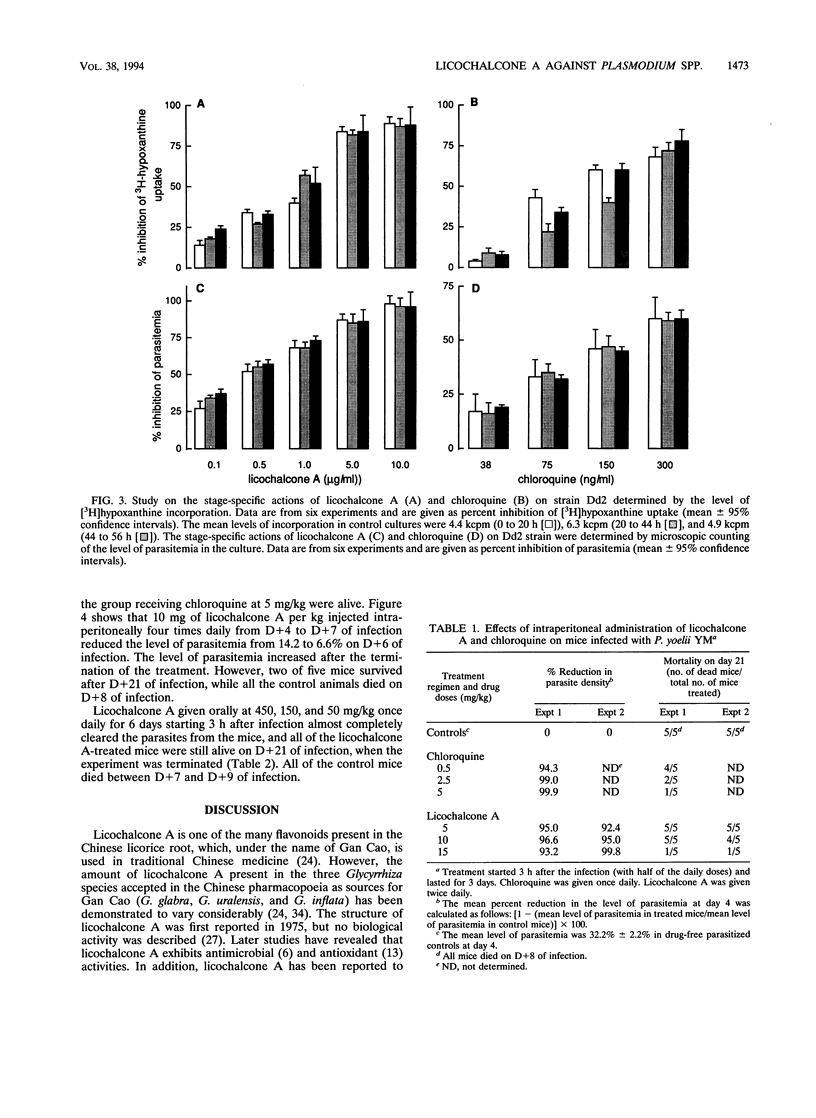
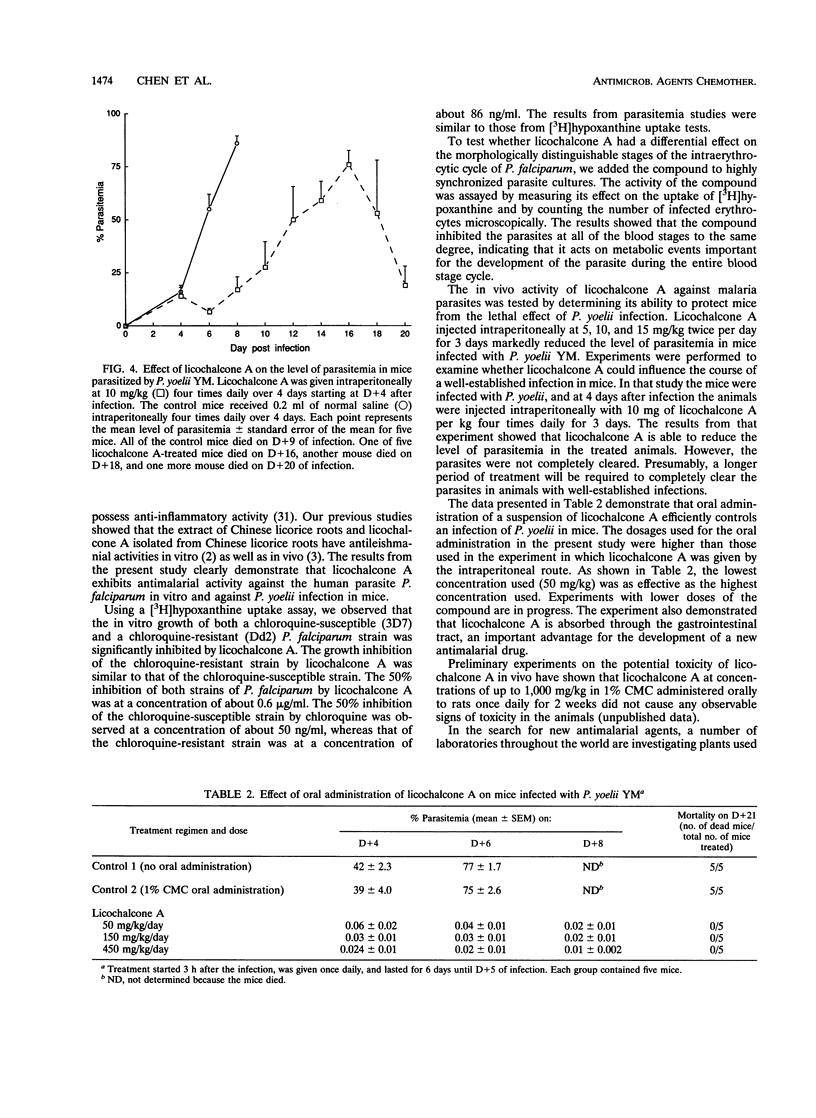
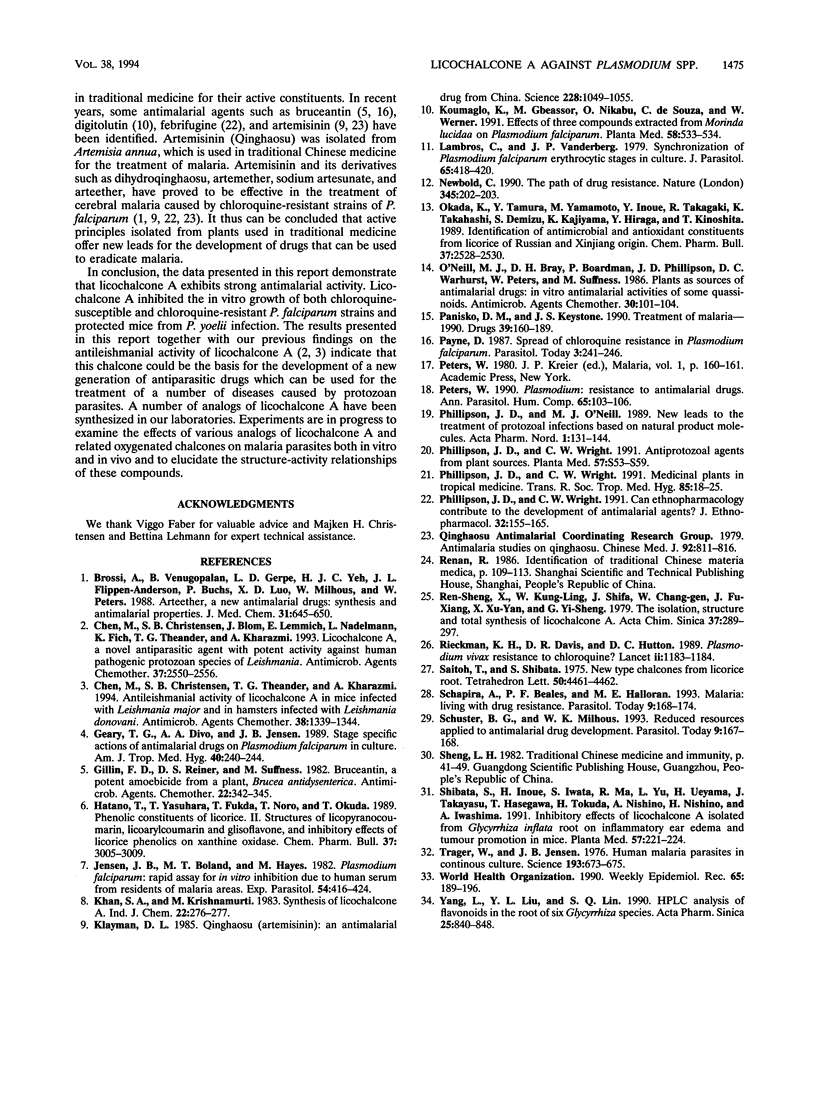
Selected References
These references are in PubMed. This may not be the complete list of references from this article.
- Brossi A., Venugopalan B., Dominguez Gerpe L., Yeh H. J., Flippen-Anderson J. L., Buchs P., Luo X. D., Milhous W., Peters W. Arteether, a new antimalarial drug: synthesis and antimalarial properties. J Med Chem. 1988 Mar;31(3):645–650. doi: 10.1021/jm00398a026. [DOI] [PubMed] [Google Scholar]
- Chen M., Christensen S. B., Blom J., Lemmich E., Nadelmann L., Fich K., Theander T. G., Kharazmi A. Licochalcone A, a novel antiparasitic agent with potent activity against human pathogenic protozoan species of Leishmania. Antimicrob Agents Chemother. 1993 Dec;37(12):2550–2556. doi: 10.1128/aac.37.12.2550. [DOI] [PMC free article] [PubMed] [Google Scholar]
- Chen M., Christensen S. B., Theander T. G., Kharazmi A. Antileishmanial activity of licochalcone A in mice infected with Leishmania major and in hamsters infected with Leishmania donovani. Antimicrob Agents Chemother. 1994 Jun;38(6):1339–1344. doi: 10.1128/aac.38.6.1339. [DOI] [PMC free article] [PubMed] [Google Scholar]
- Geary T. G., Divo A. A., Jensen J. B. Stage specific actions of antimalarial drugs on Plasmodium falciparum in culture. Am J Trop Med Hyg. 1989 Mar;40(3):240–244. doi: 10.4269/ajtmh.1989.40.240. [DOI] [PubMed] [Google Scholar]
- Gillin F. D., Reiner D. S., Suffness M. Bruceantin, a potent amoebicide from a plant, Brucea antidysenterica. Antimicrob Agents Chemother. 1982 Aug;22(2):342–345. doi: 10.1128/aac.22.2.342. [DOI] [PMC free article] [PubMed] [Google Scholar]
- Hatano T., Yasuhara T., Fukuda T., Noro T., Okuda T. Phenolic constituents of licorice. II. Structures of licopyranocoumarin, licoarylcoumarin and glisoflavone, and inhibitory effects of licorice phenolics on xanthine oxidase. Chem Pharm Bull (Tokyo) 1989 Nov;37(11):3005–3009. doi: 10.1248/cpb.37.3005. [DOI] [PubMed] [Google Scholar]
- Jensen J. B., Boland M. T., Hayes M., Akood M. A. Plasmodium falciparum: rapid assay for in vitro inhibition due to human serum from residents of malarious areas. Exp Parasitol. 1982 Dec;54(3):416–424. doi: 10.1016/0014-4894(82)90051-0. [DOI] [PubMed] [Google Scholar]
- Klayman D. L. Qinghaosu (artemisinin): an antimalarial drug from China. Science. 1985 May 31;228(4703):1049–1055. doi: 10.1126/science.3887571. [DOI] [PubMed] [Google Scholar]
- Koumaglo K., Gbeassor M., Nikabu O., de Souza C., Werner W. Effects of three compounds extracted from Morinda lucida on Plasmodium falciparum. Planta Med. 1992 Dec;58(6):533–534. doi: 10.1055/s-2006-961543. [DOI] [PubMed] [Google Scholar]
- Lambros C., Vanderberg J. P. Synchronization of Plasmodium falciparum erythrocytic stages in culture. J Parasitol. 1979 Jun;65(3):418–420. [PubMed] [Google Scholar]
- Newbold C. Malaria: the path of drug resistance. Nature. 1990 May 17;345(6272):202–203. doi: 10.1038/345202a0. [DOI] [PubMed] [Google Scholar]
- O'Neill M. J., Bray D. H., Boardman P., Phillipson J. D., Warhurst D. C., Peters W., Suffness M. Plants as sources of antimalarial drugs: in vitro antimalarial activities of some quassinoids. Antimicrob Agents Chemother. 1986 Jul;30(1):101–104. doi: 10.1128/aac.30.1.101. [DOI] [PMC free article] [PubMed] [Google Scholar]
- Okada K., Tamura Y., Yamamoto M., Inoue Y., Takagaki R., Takahashi K., Demizu S., Kajiyama K., Hiraga Y., Kinoshita T. Identification of antimicrobial and antioxidant constituents from licorice of Russian and Xinjiang origin. Chem Pharm Bull (Tokyo) 1989 Sep;37(9):2528–2530. doi: 10.1248/cpb.37.2528. [DOI] [PubMed] [Google Scholar]
- Panisko D. M., Keystone J. S. Treatment of malaria--1990. Drugs. 1990 Feb;39(2):160–189. doi: 10.2165/00003495-199039020-00002. [DOI] [PubMed] [Google Scholar]
- Payne D. Spread of chloroquine resistance in Plasmodium falciparum. Parasitol Today. 1987 Aug;3(8):241–246. doi: 10.1016/0169-4758(87)90147-5. [DOI] [PubMed] [Google Scholar]
- Peters W. Plasmodium: resistance to antimalarial drugs. Ann Parasitol Hum Comp. 1990;65 (Suppl 1):103–106. doi: 10.1051/parasite/1990651103. [DOI] [PubMed] [Google Scholar]
- Phillipson J. D., Wright C. W. Antiprotozoal agents from plant sources. Planta Med. 1991 Oct;57(7 Suppl):S53–S59. doi: 10.1055/s-2006-960230. [DOI] [PubMed] [Google Scholar]
- Phillipson J. D., Wright C. W. Can ethnopharmacology contribute to the development of antimalarial agents? J Ethnopharmacol. 1991 Apr;32(1-3):155–165. doi: 10.1016/0378-8741(91)90113-r. [DOI] [PubMed] [Google Scholar]
- Phillipson J. D., Wright C. W. Medicinal plants in tropical medicine. 1. Medicinal plants against protozoal diseases. Trans R Soc Trop Med Hyg. 1991 Jan-Feb;85(1):18–21. doi: 10.1016/0035-9203(91)90139-p. [DOI] [PubMed] [Google Scholar]
- Rieckmann K. H., Davis D. R., Hutton D. C. Plasmodium vivax resistance to chloroquine? Lancet. 1989 Nov 18;2(8673):1183–1184. doi: 10.1016/s0140-6736(89)91792-3. [DOI] [PubMed] [Google Scholar]
- Schapira A., Beales P. F., Halloran M. E. Malaria: living with drug resistance. Parasitol Today. 1993 May;9(5):168–174. doi: 10.1016/0169-4758(93)90140-b. [DOI] [PubMed] [Google Scholar]
- Schuster B. G., Milhous W. K. Reduced resources applied to antimalarial drug development. Parasitol Today. 1993 May;9(5):167–168. doi: 10.1016/0169-4758(93)90139-7. [DOI] [PubMed] [Google Scholar]
- Shibata S., Inoue H., Iwata S., Ma R. D., Yu L. J., Ueyama H., Takayasu J., Hasegawa T., Tokuda H., Nishino A. Inhibitory effects of licochalcone A isolated from Glycyrrhiza inflata root on inflammatory ear edema and tumour promotion in mice. Planta Med. 1991 Jun;57(3):221–224. doi: 10.1055/s-2006-960078. [DOI] [PubMed] [Google Scholar]
- Trager W., Jensen J. B. Human malaria parasites in continuous culture. Science. 1976 Aug 20;193(4254):673–675. doi: 10.1126/science.781840. [DOI] [PubMed] [Google Scholar]
- Yang L., Liu Y. L., Lin S. Q. [HPLC analysis of flavonoids in the root of six Glycyrrhiza species]. Yao Xue Xue Bao. 1990;25(11):840–848. [PubMed] [Google Scholar]


